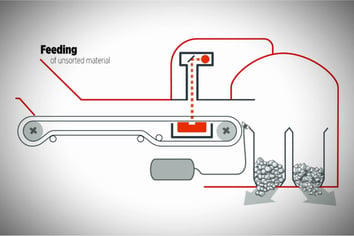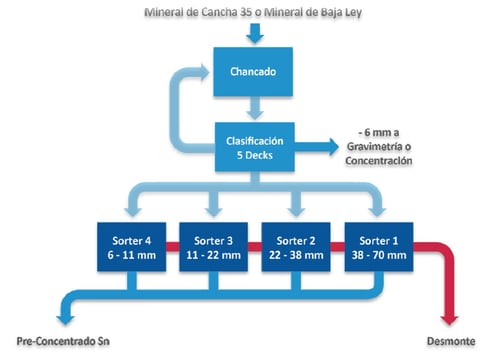Add your promotional text...
Ore Sorting: Technological Innovation in Mineral Classification
This method allows the separation of valuable minerals from waste material before the comminution and processing stages, optimizing resource use and improving the economics of mining.
Ing. Mike Hernandez
1/10/2025
In the mining industry, process optimization and cost reduction are key factors for increasing the efficiency and profitability of operations. A technology that has proven to be revolutionary in this regard is Ore Sorting, or automated mineral classification. This method allows the separation of valuable minerals from waste material before the comminution and processing stages, optimizing resource use and improving the economics of mining operations.




Applications in the mining industry
Ore Sorting has proven its effectiveness in various mining applications. In Peru, the San Rafael mine has implemented this technology with significant results. Using X-ray sensors, the average tin grade has increased from 0.6% to 2.76%, with a recovery rate of 90.4%, significantly reducing the amount of material processed and improving the profitability of the operation. This type of implementation highlights the technology's ability to transform operational efficiency and extend mine life by enhancing resource valuation.
Additionally, at mines like Antamina, pilot tests have demonstrated Ore Sorting's ability to reduce dilution and loss of valuable minerals during loading and hauling operations. This not only improves the feed grade to the processing plant but also reduces energy use in comminution and tailings handling, contributing to a more sustainable and efficient operation.
Ore sorting technology
Ore Sorting is a technology that uses advanced sensors to detect specific properties of mineral particles, such as density, chemical composition, fluorescence, etc. These sensors can automatically identify and separate valuable material from waste material using technologies such as X-rays, fluorescence analysis, magnetic resonance, among others. The technology has been successfully integrated into various mining operations around the world, highlighting its ability to improve classification efficiency and reduce operating costs.
The Ore Sorting process consists of four main elements: the feed system, sensors, data processing, and ejectors. The feed system ensures that the rocks are evenly distributed on a conveyor belt, allowing for accurate detection by the sensors. These sensors, depending on the type of mineral and desired characteristics, send data to the processing system, which makes real-time decisions on which material should be ejected.
Benefits of Ore Sorting
Key benefits of Ore Sorting include reduced operating costs, increased head grade, and optimized resource use. By separating waste material before processing, the amount of material that needs to be crushed and ground is reduced, decreasing energy consumption and other inputs. Furthermore, by improving the grade of ore fed to the plant, the efficiency of the concentration process is enhanced, yielding a higher quality final product.
Another important benefit is the reduction of environmental liabilities. Ore Sorting allows for the recovery of minerals from stockpiles that would otherwise be discarded, not only improving profitability but also contributing to environmental sustainability by reducing the generation of mining waste and the operation's ecological footprint.
Conclusion
Ore Sorting is a technology that offers significant value to the mining industry by improving efficiency, reducing costs, and optimizing resource use. Its ability to increase head grade and reduce waste generation makes Ore Sorting an indispensable tool for modern mining operations. As the technology continues to evolve, its adoption is likely to expand, further benefiting the industry in terms of sustainability and profitability.
References
Compañía Minera Antamina. (2020). Ore Sorting Technology: Implementation Stages and Lessons Learned at Compañía Minera Antamina.
Fundación Tecnológica. (2020). Automated Selective Mineral Classification (Ore Sorting). Mining Bulletin.
Contact
Jr. El Paraiso Nro. 108 Urb. El Sol De La Molina - Lima - Peru
Socials
Subscribe to our newsletter
(+51) 980 531 430
